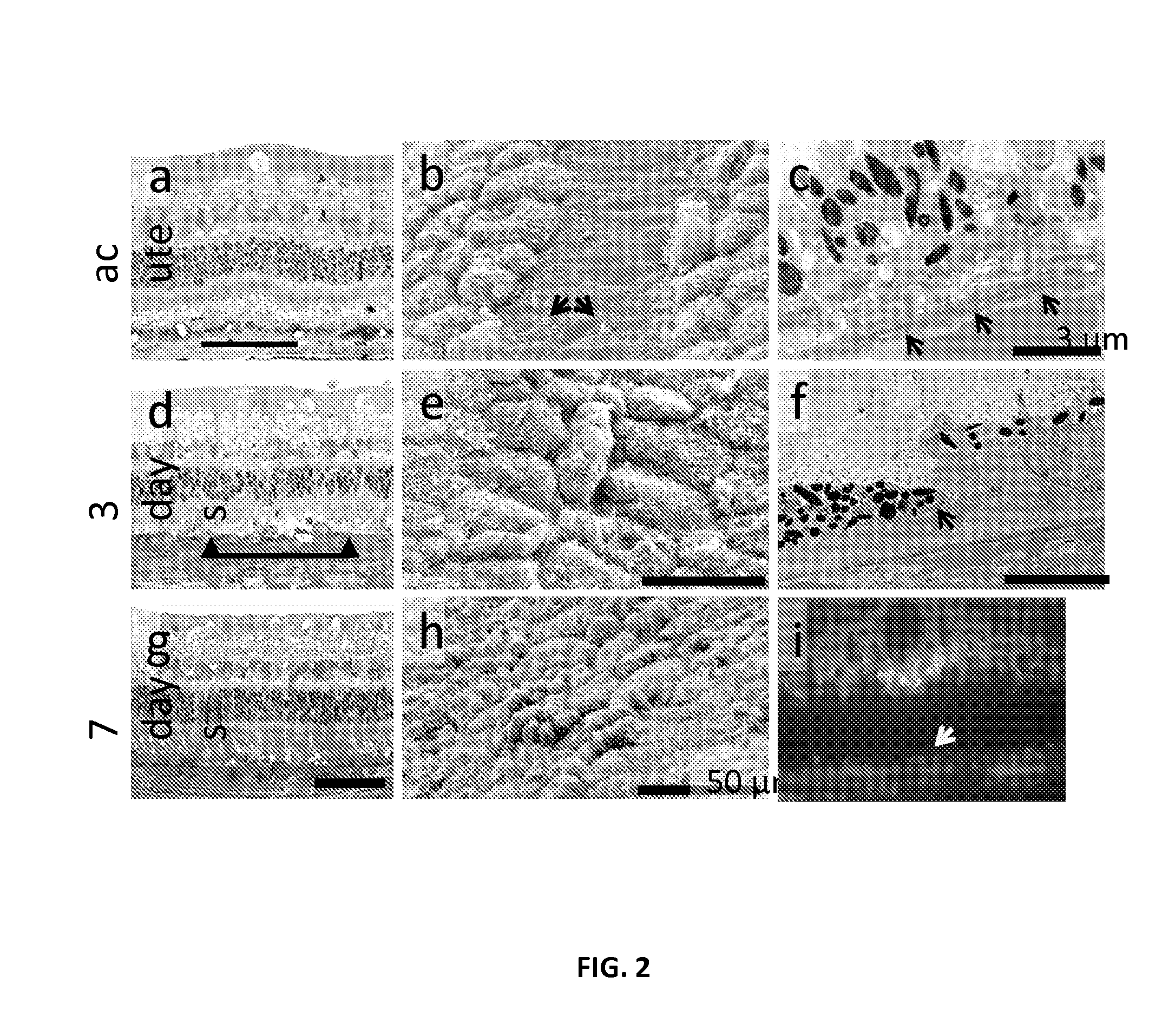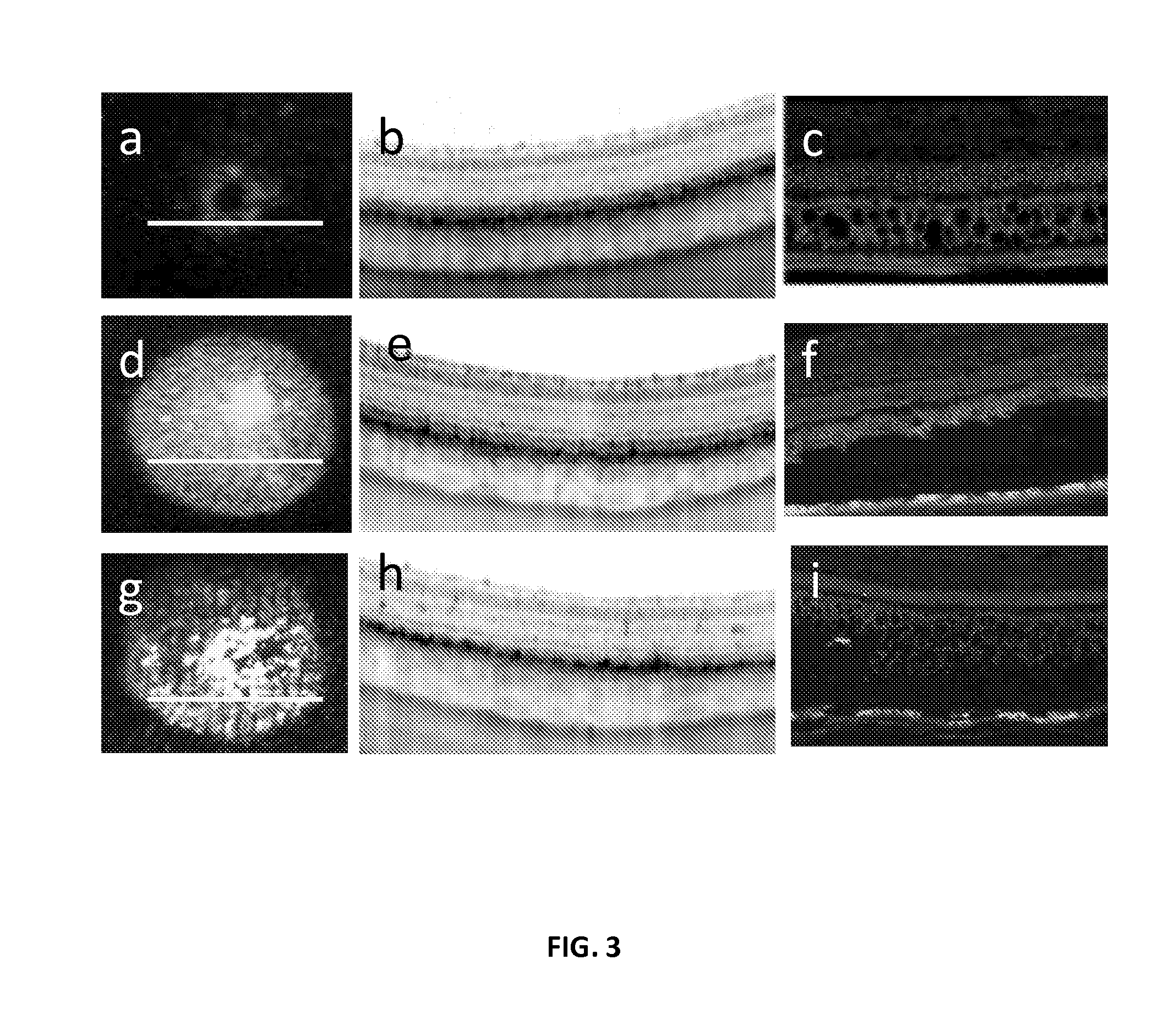Optical regulation of gene expression in the retina
a gene expression and retinal technology, applied in the field of optical regulation of gene expression in the retina, can solve the problems of undesirable persistence of expression, loss of cell division, and inability to persist in dividing cells of gene therapy vectors,
- Summary
- Abstract
- Description
- Claims
- Application Information
AI Technical Summary
Benefits of technology
Problems solved by technology
Method used
Image
Examples
example 1
Selectivity of RPE Destruction
[0199]Pigmented rabbits are transfected using a rAAV2 encoding Green Fluorescent Protein (GFP). Selectivity of RPE destruction was tested with line scanning laser in vivo using fluorescence angiography and spectral domain optical coherence tomography (SD-OCT), and confirmed with light microscopy, transmission (TEM) and scanning electron microscopy (SEM). A typical example of selective destruction of RPE cells produced by scanning laser in a rabbit eye without damage to photoreceptors and Bruch's membrane is shown in FIG. 2. Collapsed RPE cells underneath the intact photoreceptors can be seen in the histological section (FIG. 2a). SEM image shows absence of the RPE cells along the line of laser scanning one day after treatment and evidence of cellular migration by foot processes on the surrounding cells (FIG. 2b). TEM demonstrates RPE disruption with an intact Bruch's membrane underneath. Continuity of the RPE layer is reestablished in three days (FIG. 2...
example 2
Control Expression of GFP in Retina
[0201]Each eye received three subretinal injections: one with balanced salt solution (BSS), and two containing an rAAV vector encoding GFP. One bleb was left untreated for control and another was treated by SRT 3 weeks after surgery with a line scanning pattern density of 50% (i.e. laser lines were spaced one line width apart). GFP fluorescence was mapped to quantify the level of GFP expression in transfected retina over time. Possible neurosensory retina damage was monitored in-vivo using high resolution SD-OCT (FIG. 3a-b, d-e, g-h).
[0202]The time course of GFP expression and the effect of SRT on fluorescent signal was plotted in FIG. 4. Both transfected blebs reached maximum fluorescence level at 3 weeks. There was no significant increase in fluorescence signal in the BSS-injected bleb. Fluorescence in the control bleb (transfected, but not treated with laser) remained stable throughout the follow up period. The laser-treated bleb showed a 40% si...
example 3
Up-regulation of GFP in Retina by Application of Laser
[0204]To visualize the expression of heat shock protein, a transgenic mouse expressing luciferase under the control of a heat-shock sensitive promoter (HSP70) were used to visualize laser-induced bioluminescence indicating genetic up-regulation. FIG. 7 illustrates enhanced expression of the heat-shock protein HSP70 visualized by bioluminescent light emission from the treated area in an albino mouse. FIG. 8 illustrates increase of the bioluminescence with laser dose below the RPE damage threshold (40 mW) of a pigmented mouse.
PUM
| Property | Measurement | Unit |
|---|---|---|
| beam width | aaaaa | aaaaa |
| power | aaaaa | aaaaa |
| dwell time | aaaaa | aaaaa |
Abstract
Description
Claims
Application Information
 Login to View More
Login to View More - R&D
- Intellectual Property
- Life Sciences
- Materials
- Tech Scout
- Unparalleled Data Quality
- Higher Quality Content
- 60% Fewer Hallucinations
Browse by: Latest US Patents, China's latest patents, Technical Efficacy Thesaurus, Application Domain, Technology Topic, Popular Technical Reports.
© 2025 PatSnap. All rights reserved.Legal|Privacy policy|Modern Slavery Act Transparency Statement|Sitemap|About US| Contact US: help@patsnap.com



